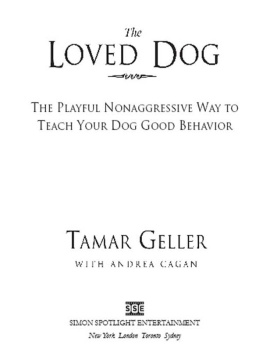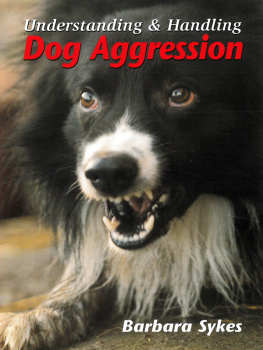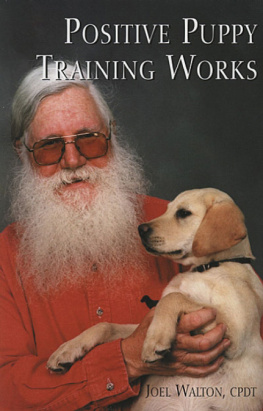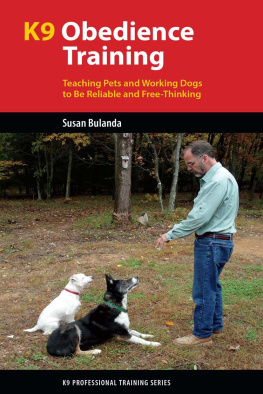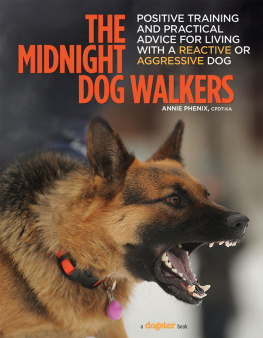
SIMON SPOTLIGHT ENTERTAINMENT
An imprint of Simon & Schuster
1230 Avenue of the Americas,
New York, New York 10020
Copyright 2007 by Tamar Geller
All rights reserved, including the right of reproduction in whole or in part in any form.
SIMON SPOTLIGHT ENTERTAINMENT and related logo are trademarks of Simon & Schuster, Inc.
Library of Congress Cataloging-in-Publication Data
Geller, Tamar.
The loved dog: the playful, nonaggressive way to teach your dog good behavior / by Tamar Geller, with Andrea Cagan.
p. cm.
ISBN-13: 978-1-4165-6297-9
ISBN-10:1-4165-6297-4
1. DogsTraining. 2. DogsBehavior. I.
Cagan, Andrea. II. Title.
SF431.G38
2007
636.70887dc22
2007003511
Visit us on the World Wide Web:
http://www.SimonSays.com
Love the animals, love the plants, love everything. If you love everything, you will perceive the divine mystery in things.
Fyodor Dostoyevsky from The Brothers Karamazov
A CKNOWLEDGMENTS
Gratitude is key in celebrating life and there are many people (and dogs) who have helped make this book happen.
Id like to thank Carrie Cook, for convincing me to write a book; Andrea Cagan, for being so open and loving to me and to animals; and Jen Bergstrom and Ursula Cary at Simon Spotlight Entertainment, for feeling so strongly about dogs.
To Eric, Tania, Lily, and Weethank you for the love, inspiration, and can do attitudeand Wee, for your amazing cooking when I came up for air!
To Lilach Barka and my team at The Loved Dogthank you for helping with everything that I asked for, and particularly for showering my doggies with love while I was spending those long hours by the computer.
To my dear Richard Beckerman, who stayed up with me until 5 AM while I was writingthank you for your understanding, support, and love.
To Wayne Pacelle and Kathy Bauchthank you for your unparalleled dedication and support of me and my work.
To my Dadthank you for sharing your love of animals, and for telling me to always follow my passion in life and never compromise.
To my beloved Clydie and Dukeythank you for the constant love and for making me go on a hike every day!
And finally, a big thanks to all the dogs and their families who invited me in and shared their stories with me. You are my teachers.
CONTENTS
F OREWORD
When Tamar Geller asked me to write the foreword for this book, she did not need to reward me with a treat or some verbal affirmation as an inducement. Ive come to know Tamar as an inspired teacher and life coach for dogs and their people, and I have seen firsthand the extraordinary results of her work. And more than that, the beliefs that underlie her work, and her life, are perfectly aligned with the the mission of the Humane Society of the United Statesand its a pleasure, on personal and professional levels, to be associated with this work.
Respect for all beings, kindness not violence, an understanding of the intrinsic value of animals, appreciating a dogs dog-ness, building bonds between people and dogs that will last a lifetimethats what keeps dogs with their families, and out of our nations shelters for homeless animals, for a lifetime.
Thats also what makes this book so much more than a dog-training manual. To be sure, youll find a trove of practical information and tips inside. But Tamar wont tell you how to teach your dog to sit so much as teach you how to inspire your dog to want to sit. Like the best coaches, shell help bring you and your dog together as a successful team.
At a time when people rightly recognize dogs as members of their families, dogs should indeed be treated with the respect and kindness wed give any other member of the family. There is wisdom in Tamar Gellers words and approach.
The how of her method is simple, and the subtitle of the book says it all: The Playful, Nonaggressive Way to Teach Your Dog Good Behavior. The why of her method is even simpler: All dogs deserve to be loved dogs. And that is a worthy goal indeed.
Wayne Pacelle, president and CEO, Humane Society of the United States
I NTRODUCTION
How the heck do you flush this thing? I asked myself. I was in a makeshift bathroom in a small guest house in Bangkok, standing over a toilet with no seat, when I realized that there was no conceivable way to flush.
I walked into the living room, my face blushing with embarrassment. Can you help me? I shyly asked the elderly woman Id met for the first time just a moment before. I couldnt flush the toilet. Im not sure what to do.
The lady of the house cracked a yellow-toothed smile and asked me in heavily accented English, You see bathtub and bucket next to toilet?
I nodded.
Fill up bucket with water and throw in toilet. That make it flush. Then you use water to wash.
I thanked her and returned to the bathroom, where I practiced my unusual and newfound knowledge. Still embarrassed, I shuddered to think what would have happened if Id been caught by the person to follow me, or if this woman had not understood me.
Wait just a minute , youre probably thinking. What do your travel adventures have to do with dog training?
The answer is: everything! When we bring a new dog into our home, he or she is like an alien entering a foreign land, with no idea how to fit in, how things work, andworst of allno way to ask for help or instructions. Then, to add insult and pain to confusion, when they do their business in the wrong place (according to us), they get their highly sensitive noses shoved into their own excrement, smacked with a newspaper, or thrown outside in shame, leaving them to wonder if these new people are safe to be around and if the natural act of going to the bathroom is wrong. Thank goodness the woman in Bangkok didnt do that to me!
Imagine if someone only spoke gibberish to you, yanked your neck, and smacked or caged you when you failed to understand. Would you feel love toward her? Whats more, the subsequent anxiety, fear, and anger you felt would make it even more difficult to calm down or to understand what you were supposed to do.
As a former Israeli intelligence officer, I have observed the horrendous methods (in my opinion) that the military used on its dogs, the same torturous techniques that many trainers still use today. They claim punishment is necessary and effective, but believe me, violence is never appropriateeven when it is disguised under some very creative-sounding dog training terms! Each time a trainer wields punishment against a dog, a disturbed animal is created. If you blindly yell and yank on your dogs leash, youre acting like an out-of-control, angry lunaticnot someone trustworthyand the dog will end up being afraid of you.
I dont believe in ever using stress, intimidation, violence, alpha rollovers, or fear. This means no prong collars, choke chains, physical correction, or anything else I call Spanish Inquisition methods, which are pain-, stress-, or fear-based. On the contrary I have found that games are the best teaching tools. The foundation of all dog coaching is as simple as changing what your dog associates with pain and what he associates with pleasure. Imagine indicating to your dog that the training session is over, and instead of his exhaling a sigh of relief and running to hide under the bed, he sits in front of you politely, his tail wagging, asking for more!
To me, teaching a dog to obey sounds militant, as if the dog has no choices and he will do what you command of himor else! Successfully training your dog is not about getting him to obey with no questions asked. Teaching manners to your dog and building a strong bond will bring you the results you want. Your dog will want to come to you. After all, you are his benevolent leader, and hes proud to be your best friend!

